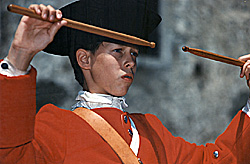 The political situation in Europe erupted into a global conflict by the
actions of a young American Colonel of Virginia Militia named George
Washington. Washington apparently in trying to capture a French delegation
under military escort managed to kill several members of that delegation
and thus began The Seven Years War or The French and Indian War. This is
somewhat of a simplification but this action along with the fact that the
French had seized forts in Ohio were causes for a world wide confrontation
that determined who would control substantial parts of North America.
The political situation in Europe erupted into a global conflict by the
actions of a young American Colonel of Virginia Militia named George
Washington. Washington apparently in trying to capture a French delegation
under military escort managed to kill several members of that delegation
and thus began The Seven Years War or The French and Indian War. This is
somewhat of a simplification but this action along with the fact that the
French had seized forts in Ohio were causes for a world wide confrontation
that determined who would control substantial parts of North America.
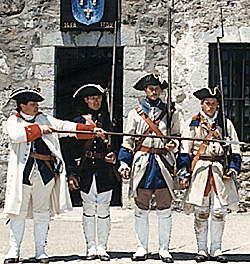 The position of Fort Niagara became a recognized strategic asset to both sides. Fortunately for the French the Iroquois remained neutral for the most part in the opening years of the conflict. To protect their strategic position at Fort Niagara the French Captain Pouchot of the French Bearn Regiment was dispatched to Fort Niagara to rebuild its collapsing defenses. The maintenance of this fortification has been a problem even to this day.
The position of Fort Niagara became a recognized strategic asset to both sides. Fortunately for the French the Iroquois remained neutral for the most part in the opening years of the conflict. To protect their strategic position at Fort Niagara the French Captain Pouchot of the French Bearn Regiment was dispatched to Fort Niagara to rebuild its collapsing defenses. The maintenance of this fortification has been a problem even to this day.
Pouchot can be credited with expanding the fort to something of its present design. The Captain built the outer earthen horn work and most importantly left his memoirs of that time as well as diagrams of his work on the fort. For all his engineering skill Pouchot was eventually forced to surrender the fort after a long siege by the British in 1759. The Seneca Indians played an important part in this by supporting the British troops besieging the place. Seneca support was not complete as various portions of the tribe were friendly with the French.
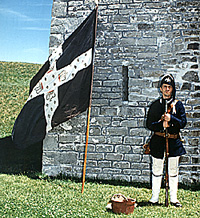 After, notice the word after, the British defeated the relieving French forces sent to help Pouchot the Seneca joined in a bloody pursuit of the fleeing French force. Later they would enter the fort and strip it of everything of value while destroying anything they could not
carry off. The British took part in the pillaging that went on. So after 30 years the Iroquois had their revenge on the French.
After, notice the word after, the British defeated the relieving French forces sent to help Pouchot the Seneca joined in a bloody pursuit of the fleeing French force. Later they would enter the fort and strip it of everything of value while destroying anything they could not
carry off. The British took part in the pillaging that went on. So after 30 years the Iroquois had their revenge on the French.
The British Period of Occupation
After the 1759 siege and fall of Fort Niagara The British were in control of not only the fort but also of the Niagara River and there by a significant portion of the Great Lakes. In consequence the French had also lost access to the her southern trade and supply routes not to mention the additional mortification of another defeat. 1759 was a year of defeats for New France.
Having secured Fort Niagara by force of arms the British consolidated their victory. Much of the north bastion in the outer horn works had been badly damaged and required repair. The French Castle or headquarters building had to be reroofed, the windows replaced and sundry other buildings in the fort required repairs or complete rebuilding. In some cases new interior buildings would also be required for the new occupying garrison.
The British repairs to original French house a major design change. The wood constructed privy or out house that the French placed along the lake side of the Castle were rebuilt.
Other changes were made to this main building, transforming it into the "Officers' Mess". The building formerly had a relatively low roof with dormers that projected more than a foot from the building's exterior walls.
Murder holes on the floor of the dormers to keep attackers from getting too close to the ground level of the building were rebuilt. The new dormers were not like those of the French but more like typical house dormers with no thought of actual defense. The old hipped roof of the French builders was redone completely. The roof was made steeper and higher. The changes to the main building were less defensive in nature. Perhaps as a result of the siege the British realized that the forts real defensive strength rested with the out works and not those of the interior buildings.
Within a decade of the British occupation of the fort a light house was installed on top of the "Mess House". Traces of the pedestal would be there in one form or another into the early 1900's although the light itself was moved to a new light house outside the main fort in 1871. Other changes saw the addition of the two stone redoubts to bolster the dilapidated French earth work; one behind the north bastion and the other located behind the drawbridge. Each redoubt was surrounded with a stockade of some sort.
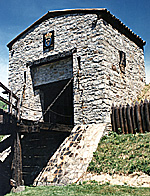 The stone "Head House" (at right) of the drawbridge is an interpretation of the original drawings by the renovators of the site during the late 1920's.
The stone "Head House" (at right) of the drawbridge is an interpretation of the original drawings by the renovators of the site during the late 1920's.
The redoubts are quite unique in themselves being identical in many ways but not all. Each redoubt was built with tapered walls of varying thickness with the thickest portion at the base of the building. They measure about 48 feet square rising about 30 feet above the ground.
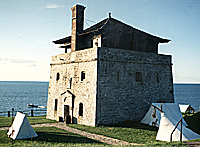 Both structures have been renovated many times since their original
construction. These renovations changed as did the purpose of the
functionality of the redoubts changed. The north redoubt (photo at left) covered the lake
side of the north bastion creating defense in depth--first as a powder
magazine then seeing service as the fort's guard house and then as a
storehouse.
Both structures have been renovated many times since their original
construction. These renovations changed as did the purpose of the
functionality of the redoubts changed. The north redoubt (photo at left) covered the lake
side of the north bastion creating defense in depth--first as a powder
magazine then seeing service as the fort's guard house and then as a
storehouse.
The south redoubt was a second defense to the main gate. Unlike the north redoubt which had only one entrance at the ground level, the south redoubt had a double entrance which formed a large gate way into the fort accessing the parade ground. In both buildings the second floors provided a guard room and the third floor provided a gun platform for field guns. The interior floors and platforms were constructed of wood.
The redoubts were roofed in a pagoda or Chinese style. The roofs were designed to be dismantled completely. The entire upper roofing section timbers were notched and utilized wood pins which would make dismantling easier. In the event of another siege the roofs would be removed in order to reduce risk of fire and casualties. The framing if left in place would cause splintering by direct hits of artillery fire.
The remaining French buildings, earthen walls and palisades were repaired or replaced. The British may have constructed more barracks buildings or replaced the existing one entirely. Certainly the French bake ovens just in front of the Castle was rebuilt only to burn down in 1761. Today the original brick ovens are visible within the British addition.
The French stone powder magazine was relatively untouched during the siege however the entrance was changed and buttresses were added. The French warehouse behind the Dauphin battery was certainly modified in 1762 and saw some use as a stable. The artifice buildings on the river side were also redone. Other interior buildings of wood were constructed including a hospital and various officers' lodgings.
All the while the British were modifying old and constructing new buildings at Fort Niagara. The fort was a part of a larger system of British outposts that defended the frontier of the colony of New York. Fort Niagara's garrison was divided among the various posts with each company being rotated to a different post on a regular basis. In that same year the Indians threatened these posts and Fort Niagara had a supply train and its escort ambushed at a place along the Niagara River called "Devil's Hole". Here the Indians drove the supply wagons of the column over the cliffs of the river and massacred the escort.
More Old Fort Niagara
-
Old Fort Niagara Introduction
Forts Conti and Denonville (slow: 175K)
Siege of Fort Niagara during the French and Indian War (slow: 200K)
American Revolution and War of 1812 (slow: 263K)
A Brief Tour of the Existing Buildings (75K)
Conclusion and Contacts (slow: 187K)
Bookstore Buys
Re-enactors and Fort George Photos (very slow: 408K)
Pre-renovation: 1926 Photos (very slow: 268K)
1909 Postcard of Old Fort Niagara (slow: 165K)
Back to List of Battlefields
Back to Travel Master List
Back to MagWeb Master List of Magazines
© Copyright 1997 by Coalition Web, Inc.
This article appears in MagWeb (Magazine Web) on the Internet World Wide Web.
Other military history articles and gaming articles are available at http://www.magweb.com